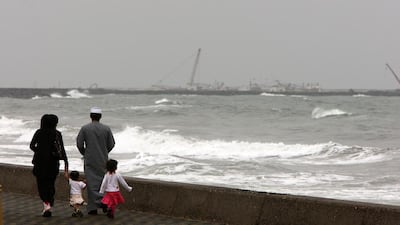A low pressure system that dropped rain in parts of Saudi Arabia, Bahrain and Qatar on Saturday is expected to move into the UAE overnight leading to potentially “unstable” weather on Sunday and Monday.
“We are expecting that by Saturday night the amount of cloud will increase over the western areas and islands and the northern areas and we are going to witness convective clouds associated with rainfall and maybe fresh winds at times,” a forecaster with the National Center of Meteorology said.
Rain clouds will continue to gradually amass throughout the day on Sunday and into Monday morning, when the system is expected affect the northern areas of the UAE. The NCM is also planning to fire cloud-seeding flares to help enhance the rain when the clouds move into the country.
“One other thing that will happen Sunday and Monday is a drop in temperature,” the forecaster said. “We are going to see a significant drop in temperature.”
The NCM considers a drop of four degrees or more as “significant.”
_______________
Read more:
The rain men: everything you need to know about UAE's cloud seeding missions
WATCH: How cloud seeding works in the UAE
_______________
Sunday’s forecast calls for a high of 29°C in Abu Dhabi and 30°C in Dubai. But once the low-pressure system moves in, the mercury is expected to fall.
“Let’s say between noon and the evening because during this time it will be cloudy and rainy, so for that reason we are expecting a significant drop in temperature,” according to the meteorologist.
Southeasterly to northeasterly winds will blow between 14 to 30 kph, gusting up to 48 kph over land and reaching 65 kph over the sea. Offshore waves in the Arabian Gulf could become rough to very rough, climbing to almost 4m at times. The Sea of Oman will be rough as offshore waves swell to 2.5m.
The cool, strong winds may cause blowing dust and reduced visibility at times.
“It’s a pressure system that is moving from the west to the east, which is normal for this time of year,” said the forecaster.

